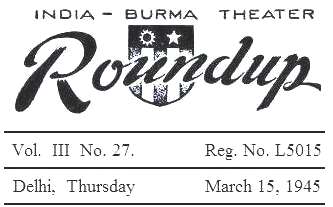
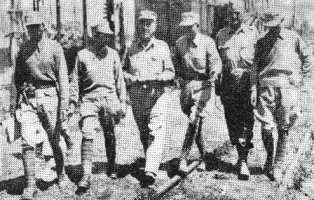 Entering Lashio shortly after its capture, Lt. Gen. Dan I. Sultan, Theater Commander (third from left), and Lt. Gen. Sun Li-jen, Commander of the New Chinese First Army (fourth from left), emerge safely from under Jap artillery fire after an enemy shellburst cratered tracks 35 yards from the inspecting party.
Entering Lashio shortly after its capture, Lt. Gen. Dan I. Sultan, Theater Commander (third from left), and Lt. Gen. Sun Li-jen, Commander of the New Chinese First Army (fourth from left), emerge safely from under Jap artillery fire after an enemy shellburst cratered tracks 35 yards from the inspecting party.
|
British Encircle Mandalay Nips;
Lashio Seized
The war in Burma has taken a tremendous stride forward the past week, with Lashio in the hands of the Chinese First Army and the British 14th Army inside Mandalay, second city of Burma.
The capture of Lashio by the Sun Li-jen troops of Lt. Gen. Dan I. Sultan's Northern Combat Area Command climaxed the drive that started south of Myitkyina last fall. The entire Burma Road from Lashio to Kunming is now in Allied hands.
FLYING COLUMN
The British sent a flying column out from the 19th Indian Division and these troops smashed right into Mandalay. The last reports are that the British were clearing the city, with the Nips holed up in Fort Dufferin. Combat Cargo planes are airdropping supplies to the British.
The British are all around the city, with other elements reported to be heading to the east from the recently-seized Meiktila Air Fields, the prize of an airborne operation. The British Second Division is on a continuous line from Kyauktalon to Myotha, 30 miles southwest from Mandalay.
Headquarters of the 14th Army estimates that 50,000 Japanese are trapped in the pocket between Mandalay and Meiktila.
DIRECT ASSAULT
The Chinese made a direct assault on Lashio after surrounding the city from three sides. They seized the sirfield and old Lashio, then took new Lashio. Latest reports from NCAC place Chinese advances towards Hsipaw, with leading units on the halfway mark from Namtu.
Maj. Gen. Francis Festing's veteran 36th British Division has consolidated its position inside recently captured Mongmit, between Namtu and Twinnge. Mongmit is a communications center 140 miles southwest of Mandalay.
CAPTURE OF LASHIO CAMPAIGN'S CLIMAX
By S/SGT EDGAR LAYTHA Roundup Staff Writer
LASHIO - The curtain slowly falls. Passing of the first Ledo-Kunming convoy was the climax. Lashio was the grand finale of the North Burma campaign. The pitiful exposure of dwindling Japanese energies was even over shadowed by the dynamic implications of this great final victory.
I walked in the wake of the retreating Jap into quite a few of his former Burma strongholds. He virtually had to be kicked out of ebery possible hole before the place was ours. But here, in the rubble of Lashio, his resistance was so disintegrated by the American-controlled and manned fire direction that it was just a matter of artllery concentration to make him run. In Lashio the Jap was no more the tenacious foe of Bhamo fame; the bowlegged bastard was on his last lap.
90 A MINUTE
Nonetheless, Lashio did not fall without a fight. The Jap made a stand with fury at the 24-mile mark north of the city, but was forced to withdraw in the face of our intense artillery fire of 90 rounds a minute. He made another stand at the 12-mile mark, which was already lacking in ferocity and determination. Less than a week later came his fatal fadeout at Lashio.
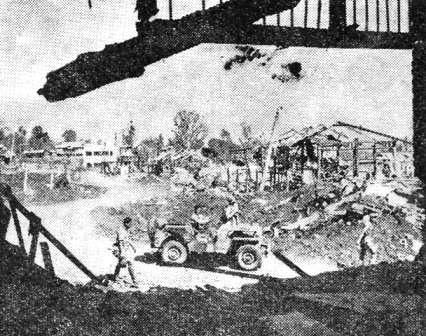 After a final plunge down the Burma Road, Chinese troops enter bomb and artillery-shattered Lashio, former strategic
supply terminal of the overland route to China.
After a final plunge down the Burma Road, Chinese troops enter bomb and artillery-shattered Lashio, former strategic
supply terminal of the overland route to China.
|
For us the victory meant road security for the Stilwell highway, 105 miles to the north. Wehave also captured with Lashio the hinge of one Japanese escape route into Thailand from North Burma, and we have compressed the enemy into a zone of action which eases the British drive to Mandalay. That is, we have eliminated any threat to the British from possible Japanese flank moves to the northeast.
BOOM TOWN
I walked through the ugly ruins of a once ugly town. Absent was the pathetic splendor of other fallen Burman towns. No shattered Buddhas on golden pedestals, no peacock parasols in the dust. Before the Japs made it their main supply depot in North Burma, Lashio was the hungry boom town of opportunistic merchants who streamed in the middle thirties to the then new Burma Road terminal and built and ugly modern town a few miles from the old village of Lashio.
The landmarks of this new Lashio were the filling stations of the India Burma Petroleum Company. I saw them on the corners, in rather good shape, but the business buildings were mostly shattered.
BROTHEL BUILDING
Incidentally, the Japanese garrison brothel remained in pretty good shape. It was the largest building in town, the former office of an Indian timber company. The floors were littered with Japanese admission passes, which I was told were issued once a week to every soldier by his company commander. The inmates, who fled with the Japanese, were Korean girls. Lashio natives told me the girls were hired for these patriotic duties by Japanese military agents. The poor girls had been told to follow an internationally accepted custom and were shown photographs of Red Cross girls for proof.
CHINESE VICTORS
The Chinese victors in the city were in exceedingly good form. They seemed to sit on top of the world. They were conquerors and looked it. It was again their pugnacious 38th Division which as usual spearheaded the drive into Lashio, the birthplace of the unit. They had been activated just one month less than three years ago when General Joseph W. Stilwell brought them from China into Burma.
 Dolores Moran of the movies has another title. She's been selected by the crew of the aircraft tender
USS St. George as their "tender girl."
Dolores Moran of the movies has another title. She's been selected by the crew of the aircraft tender
USS St. George as their "tender girl."
|
I-B SOS Draws Praise In WD Covell Letter
The effective work done by the Service Forces in the India-Burma Theater was praised this week in a letter from Under-Secretary of War Robert P. Patterson to the SOS commander, Maj. Gen. W. E. R. Covell.
In commenting on the pride of the American people in the accomplishments of the men under Covell's command, Patterson said, "I have in mind the hard and steady work done by the men who unload ships at Karachi and Calcutta; by the railroad battalions operating the Burma-Assam narrow gauge railroad; by the supply troops in Calcutta, Chabua and Ledo; by the Engineers constructing the pipelines; by the Engineers building and maintaining the Ledo Road; and by the troops handling the convoys to Burma and China."
CHENNAULT SAYS 14TH RULES AIR
CHUNGKING - In a broadcast from here this week on the second anniversary of the 14th Air Force, Maj. Gen. Claire Chennault said, "I think I can say now that we enjoy air superiority over all of occupied China," adding he believed the Japanese "are attempting to dig themselves in for a last stand in China, Manchuria and Korea as well as their own islands, but I can see no way they can avoid Allied landings in Japan."
CHINA REDS SPURN CHIANG GESTURE
CHUNGKING - Chinese Communists this week spurned an invitation to a National Assembly, which Generalissimo Chinag Kai-shek has called for November to form a China Constitutional Government, terming it a "congress of slaves," and accusing Chiang of plotting to swallow the Communist armies.
The statement, which apparently broke up all hopes of settling a longer dispute, also called the Generalissimo a despot and dictator who should be removed and punished.
|
MILEPOSTS
WASHINGTON - Sixty-five per cent of the more than 15,000 soldiers used in the construction of the Stilwell Road to China were Negro troops of the U.S. Army Services of Supply, the War Department announced this week. A detachment of Negro Engineers, the 843rd Engineer General Service Regiment, using British and American equipment, first began work on the Road at Ledo. Twenty-five months later, T/5 Richard Barnett drove the leading vehicle of the first convoy to China over the completed highway. The announcement praised the Negro troops for doing a job that had been termed "impossible." Graves of the dead along the Road testify as to how impossible the task really was, the announcement said. The Road is 1,004 miles along, most of it through enemy territory, and there is a grave for every mile. |
Treed Operator Gets Grounded
1333RD BU, ASSAM - S/Sgt. Jacob Rabatin, Jr., has been "grounded."
When Rabatin came to this base back in March, 1943, he was appointed the field's first "control tower operator." It was a nice setup. His would be strictly a daytime job. His control tower afforded plenty of fresh air and sunshine.
On the other hand, it wasn't such a nice job. For one thing, the tower was located in the lofty branches of a tall tree. Four times a day, at least, he had to climb a ladder up the tree's trunk. During the monsoon, his office had altogether too much running water. The field was doing lots of business, too. ATC cargo planes and a B-24 outfit made an average of 100 landings per day. An then, of course, there were the Japs.
Bu that was all long ago. Today, at his new desk in a modern glass-enclosed tower in the operations building, Rabatin is a happier man. He's working a regular six-hour shift. The danger of enemy bombing has been eliminated. There's no more tree climbing. And, best of all, he's up for rotation.
 The New York World-Telegram decided that weather reports needed a little color so they dragged them out of their
sacred place near the masthead and put them in a boxed head, written around a feature angle. But Maj. John A. Haas, Jr.,
staff officer of the 10th Air Force, went a step further. He decided to go on the line that one picture was worth a
thousand words and used cheescake to liven up his lectures on the perambulations of Jup Pluvius. At left is shown a
violent cumulo nimbus formation, which reaches the height of its turbulence around the edges, with the gal below
supposed to represent the same idea. Center, dangerous stratus clouds, which shroud mountain tops and are often called
:rock-lined clouds." And at right the turbulent cumulo clouds, which toss airplanes around like tops. We think the boys
get the idea. In fact, knowing the 10th, we are sure they do.
The New York World-Telegram decided that weather reports needed a little color so they dragged them out of their
sacred place near the masthead and put them in a boxed head, written around a feature angle. But Maj. John A. Haas, Jr.,
staff officer of the 10th Air Force, went a step further. He decided to go on the line that one picture was worth a
thousand words and used cheescake to liven up his lectures on the perambulations of Jup Pluvius. At left is shown a
violent cumulo nimbus formation, which reaches the height of its turbulence around the edges, with the gal below
supposed to represent the same idea. Center, dangerous stratus clouds, which shroud mountain tops and are often called
:rock-lined clouds." And at right the turbulent cumulo clouds, which toss airplanes around like tops. We think the boys
get the idea. In fact, knowing the 10th, we are sure they do.
|
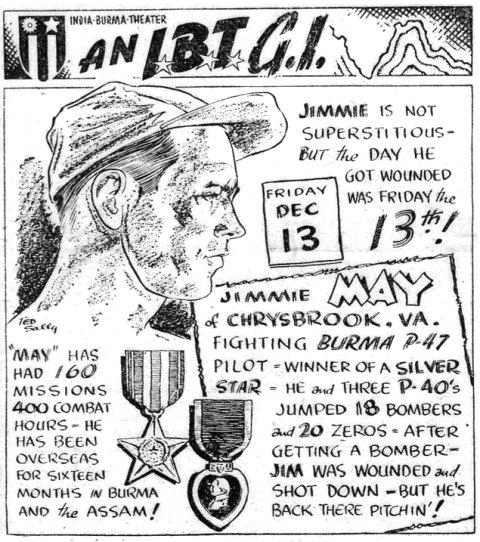
|
Examine Rupee Notes,
Warns Fiscal Officer
American military personnel are carelessly accepting mutilated Indian currency despite previous warnings, says Lt. Col. John E. Kirk, Central Funding Officer of this Theater.
The Central Office is receiving about 2,000 notes monthly of one, two, five and 10 Rupee denominations for redemption. The notes are sent here from fiscal officers at various Theater APO's.
However, the only ones that are sent in for redemption are notes that can meet the rigid requirements laid down by the Reserve Bank of India for redemption. Notes of 10 Rupees and under must contain the entire serial number and more than 50% of the original physical structure.
TWO PREREQUISITES
If the notes you possess do not have both prerequisites, they are valueless and can be added to your souvenirs. They will not be redeemed. This, however, does not hold true of 100 Rupee notes or above. The serial number and any part of the note will be considered for redemption.
Kirk suggests that men who have been stuck with mutilated or discolored notes see their finance officers. In some cases they will forward the notes to Delhi for redemption, but they are not required to do so, since they are personally accountable for all losses.
SAFETY RULES
Kirk urges that all American military personnel follow the following rules if they want to avoid loss:
Don't accept torn, soiled or worn Rupees from anybody. Insist on notes in good condition, with serial number clearly visible.
Take proper care of all notes. Do not fold one, two or five Rupee notes. If you must fold them, do not fold them in the center where the serial number is printed, for after a while the number will begin to wear away.
Fold 10 and 100 Rupee notes lengthwise only.
SERIAL NUMBER
Whenever you get a torn note, paste it together with transparent tape only. If you haven't any transparent tape, use some other type on the reverse side only. The serial number is on the face of the note and should always be visible.
Be especially careful of the 10 Rupee notes issued in December, 1944. By holding it up to a bright light you'll see a parchment paper line in it just right of the center. This line is there to prevent counterfeiting, but has a tendency to be weak at just that point and often tears easily. If that happens, the note is valueless. Incidentally, most counterfeit Indian currency comes in 10 Rupee denominations.
RECORDS SET IN UNLOADING AT CALCUTTA
CALCUTTA - A new unloading and "turnaround" time record was made here this week when the port organization of Base Section No. 2 discharged a Liberty ship in 44 hours and 30 minutes.
The new mark is approximately 90 minutes better than the previous mark set here in August of last year and was performed as a normal routine of operation - without any special preparation or additional men, machinery or transportation.
The ship entered the docks, was unloaded and moved out in two days and five and a half hours, according to Brig. Gen. R. R. Neyland, installation commander. Neyland paid special tribute to the enlisted men of the port company for their efforts in keeping the Calcutta port at the top of the list of military ports in the world.
In a letter of commendation to the Company, Maj. Gen. W. E. R. Covell, Theater commander of the service forces, praised the organization and officers responsible for the record smashing performance.
Col. L. M. Rose is the base transportation officer; Lt. Col. J. G. Fort operates the port transportation system, and Capt. E. F. O'Neill, Lt. James J. Farren, and Lt. James F. Weist are others responsible for the port efficiency.
ARMY AWARD TO SEAGRAVE NURSE AIDES
WASHINGTON - Nineteen nurses of the Seagrave hospital unit in Burma during the early part of 1942 have been recognized for their heroic service and devotion to duty by the award of a Bronze Star Medal, the War Department announced here last week.
A posthumous award was made to Miss Luzon Stulum who gave her life in service. Her citation says: "For heroic and meritorious service in connection with military operations against the enemy of the United States from Jan. 9 to March 24, 1942.
SEVEN HOSPITALS
"Miss Stulum supervised in a most efficient manner the nursing services of seven widely separated hospitals of the Harper Memorial Hospital mobile surgical unit serving the Chinese Sixth Army in the Southern Shan States.
"In the absence of medical officers she organized and operated a 100-bed hospital at Mong Pam until her death while on duty driving a light truck, which served as an ambulance, on March 24, 1942. This outstanding service reflects great credit on the entire nursing profession."
The decoration was awarded to the other 18 for "heroic and meritorious service in connection with military operations against the enemy of the United States from Jan. 19 to Feb. 20, 1942."
LIMITED SUPPLIES
The citation states: "As nurses in a medical unit organized to provide aid for Allied forces fighting in Burma, they underwent indescribable hardships and fatigue, worked with limited supplies and facilities, and yet saved many lives and did much to maintain the morale of the troops."
SHOVEL, COBRA, RAIN ALL IN BURMA TALE
BURMA - The tallest story of the week was told here by T/5 Joseph F. Medler of a medical unit.
Medler relates that one day while digging a fox hole a cobra reared up from the nearby elephant grass and struck at him. But the cobra missed and sunk its fangs into the shovel handle.
"Next morning I found the shovel lying where I left it, but boy, what a shovel handle! I hardly recognized it. It had swelled to surprising proportions. Deciding to make good use of the incident, we took the shovel handle to the Engineers and had timbers and planks made from it. We built a garage for repairing trucks and finished in a few days.
"One day it started to rain and that building started shrinking. That deluge was washing out the poison and that thing shrunk so fast we couldn't get out the trucks that were there. When it stopped raining, all that was left was two pieces of battered junk and a few splinters of wood."
That is Medler's story. He concludes with the fact that he has 40 G.I.'s in his unit to back up his yarn. He says, "Just ask them!"
FATHER, SON TEAM WORKS AT ASC DEPOT
AIR SERVICE COMMAND DEPOT, BANGALORE - This ASC installation now has a father and son team working together in M/Sgt. John A. Breitschopf and his 25-year-old son, Cpl. John C. Breitschopf.
The elder Breitschopf enlisted in a Minnesota National Guard, 109th Observation Squadron. His son joined the same outfit in 1940, both being together for over a year.
At Esler Field, La., the son transferred to a bombardment squadron and served in the East as his father remained at Esler until sent to Greensboro overseas replacement depot last August. The son caught up with his father at the same station and both came to India together in November.
The 53-year-old father, who obtained overseas service after strenuous effort, is a chief aircraft inspector, while the son is airplane and engine mechanic. Another son, Maj. Kenneth, Jr., is now an ATC pilot at Hamilton Field, Calif., after having completed 20 months flying The Hump in this Theater.

Cloak Removed From Activities Of Photo Unit
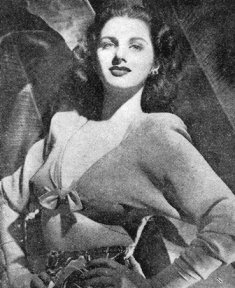 Of all places in the world, this pinup of gorgeous Marjorie Riordan, Hollywood starlet, was discovered on a barracks
wall by a Roundup staffer, whose wolfish eyes were attracted by her limpid eyes and other things. He escaped
with it amid a hail of bullets to bring same to all you lucky readers.
Of all places in the world, this pinup of gorgeous Marjorie Riordan, Hollywood starlet, was discovered on a barracks
wall by a Roundup staffer, whose wolfish eyes were attracted by her limpid eyes and other things. He escaped
with it amid a hail of bullets to bring same to all you lucky readers.
|
HQ., EASTERN AIR COMMAND, INDIA - Presence of the 10th Combat Camera Unit, which has been photographing Jap installations and terrain in the India-Burma Theater for the past two years, was officially announced this week by Maj. Gen. George E. Stratemeyer's command.
Operating in closely-guarded secrecy since coming to this Theater, the 10th Unit has exposed more than 200,000 feet of combat, operational and documentary motion picture film plus many thousands of still negatives.
2,100 HOURS
Members of this unit have flown over 2,100 combat hours in bombers, gliders, transports and liaison aircraft, taking aerial pictures of the Burma jungle, and the Rangoon, Mandalay areas.
The unit's photo reconnaissance of the North Burma area in March, 1944, showing the location of enemy glider obstacles, played a great part in the successful airborne invasion by the late Maj. Gen. O. C. Wingate's Chindits. Praising their work in this campaign, Col. Philip Cochran said the unit's filming of the area "saved our entire operation."
THRILLING TALES
Returninf from their dangerous missions, each member has a new thrilling story. Cpl. Norman Delair was photographing Rangoon recently when a burst of flak shattered his goggles without injuring him. Capt. Clifford Shirpser and Lt. Irving A. Greenspan, who fly a C-46, tell of hiding in a convenient cloud while Jap planes were attacking an Allied airbase in China.
The 10th Combat Camera Unit's slogan, which is also their only order, "Get it on film and get back with it." They're doing just that every day.
Burmese Find New Freedom
MARS TASK FORCE HQ. - Burmese found the difference between American and Japanese ways of of life on the recent march of the Mars Task Force through Northern Burma.
During the three weeks of fighting the only Burmese to be seen were those who had been organized as litter-bearers and handymen. They were well fed and worked accordingly.
Then one day a file of about 20 natives came down the trail to the 124th Cavalry Hq. One of them led a fat bull. They stopped near some Kachin Rangers. Headmen explained their mission was to obtain passes permitting free movement of their people through the territory occupied by the Mars Task Force and the Chinese.
A Chinese liaison officer prepared the passes and it was explained to them feee passage was permitted. Until this time the people had been barred from the region and confined to their villages.
When word spread that the Americans and Chinese would permit them to move about unmolested, unlike the Japs who had severely restricted them, the villagers swarmed out of hideouts in the hills. They had been holed up there since the Jap conquest of the region.
'Fleet Service' Aiding I-B Air Passengers
ICD HQ., CALCUTTA - Another step in ICD's paln to give airline passengers in this Theater service as near Stateside as possible is its new "fleet service," a catering device now in operation.
"Fleet Service" is merely a two-wheeled trailer pulled by a tug, which contains just about everything required to enhance the passenger's comfort - blankets, magazines, clean seat covers, K-rations, plates, cups, thermos jugs, fruit juices, aerosol bombs, mop, broom and even toilet paper.
The trailer was devised to shorten intermediate stops at bases to less than half an hour. When a plane lands, the fleet service crew sets to work sweeping out trash, mopping the floor if necessary, replacing soiled seat covers, furnishing blankets and replenishing the ship's larder.
COL. ELMER E. ELMER CITED FOR 17 RAIDS
XX BOMBER COMMAND, INDIA - Scribbled on the bottom of a B-29 group interrogation report recently was a recommendation that "Lt. Col. Elmer E. Elmer be promoted for his superior combat efficiency."
Channeled through to XX Bomber Command Headquarters, the recommendation confused personnel officers. After a futile search through their files, they radioed group headquarters: "Who is this Col. Elmer? We have no record of him."
Elmer, subsequent investigation revealed, was just about the most human cotton-stuffed teddy bear ever to accompany a Super-Fortress crew on combat missions against Japan as a combination mascot-talisman.
CREW MEMBER
 Maj. Charles J. "Deacon" Miller, of Dexter, Mo., veteran pilot of the XX Bomber Command Super-Fortress "Deacon's
Disciples," holds the plane's mascot teddy bear, Col. Elmer E. Elmer, at a B-29 base in India.
Maj. Charles J. "Deacon" Miller, of Dexter, Mo., veteran pilot of the XX Bomber Command Super-Fortress "Deacon's
Disciples," holds the plane's mascot teddy bear, Col. Elmer E. Elmer, at a B-29 base in India.
|
Completely outfitted with a flight cap, insignia, decorations and parachute, Elmer is a regular crew member of "Deacon's Disciples," a battle-seasoned B-29 piloted by Maj. Charles J. "Deacon" Miller of Dexter, Mo.
The fuzzy mascot's red silk parachute was made by Mrs. John C. Eckmann, wife of the flight engineer.
Elmer is a familiar sight at the group's mission briefings and interrogations. Rated a "command pilot," he rides with the gunners on all missions.
BLOOD TYPE
The crew members regard the honey-colored teddy bear as an animate human entity and always refer to him as such. He wears dog tags stamped "Elmer E. Elmer" (the "E" of course stands for "Elmer") and blood type is marked "C" - for cotton.
Elmer, who has been with "Deacon's Disciples" since the group's early training days at Great Bend, Kans., in 1943, has a somewhat obscure past. Miller and two other pilots of the group, then flying with the Air Transport Command, found Elmer in their possession after a gay evening. All three claimed Colonel (then Captain) Elmer, but Miller abducted him.
"The other pilots, still flying with our group here, have sworn to snatch Elmer back with them the first chance they get," Bombardier Lt. Arthur E. Morrill of Nashua, N.H., said. "So our gunners are a self-appointed committee of four to act as his bodyguards."
17 MISSIONS
Elmer has flown on 17 missions and wears a color-splashed "fruit salad" of combat awards on his furry chest.
"Actually he has flown more missions than we have," Morrill declared. "He accompanied an alternate crew twice on our plane. We sweated him out both times and then decided the strain was too much. We were worried that another crew might not see him safely out of the plane in case anything happened. Now he flies only with us."
Negro ARC Girls Help Introduce New Rest Camp
CALCUTTA - Negro Red Cross personnel, including three Negro Red Cross girls, will staff the Red Cross club that features the new rest camp for Negro troops at Dum Dum Orphanage in Calcutta.
The new rest camp was officially opened by Maj. Gen. W. E. R. Covell, commanding general of Services of Supply.
The new camp is housed in large, stone construction buildings, vastly different from the basha huts of last year. Troops have already moved in and while many improvements are still to be made, the camp is in full operation and no more men are being sent to Howrah for vacations.
DUM DUM BETTER
In talking to the assembled soldiers, Covell frankly admitted that conditions had not been up to par at Howrah and said he hoped to make Dum Dum as good or better than any camp in the Theater.
All the facilities at Dum Dum are basically good. There are plenty of showers, a clean kitchen and a pleasant mess hall. There is a well stocked PX and a Red Cross canteen in addition to the regular club.
PLENTY TRANSPORTATION
The commanding officer of the new camp is Capt. Harold D. Ellrod. Assisting Ellrod are two Negro chaplains, Capts. Cassius Ellis and Arthur crowell.
Camp authorities have promised that there will be plenty of transportation available to the downtown area.
The Red Cross club was hard-pressed to make ready for the official opening. But as one of the girls, Inda Lee remarked, "We are going to make it as good as any other installation in the Theater."
EPU SHOW
In addition to Covell's talk, Brig. Gen. Robert P. Neyland, Base Section Two chief, gave a short discourse. Maj. Melvin Douglas introduced one of his Entertainment Production Unit shows. Virgil Hummer, "The Westernaires," Bob Clem, Ed Doyle and Hal Devine highlighted the program.
Negro Red Cross girl Margie Johnson also sang, accompanied on the piano by Jeanette Dorsey, another of the ARC Negro contingent in the Theater.
 Brig. Gen. J. M. Thompson, Theater G-4, was reunited with his son, Lt. William A. Thompson, when the latter flew his B-24 in from the States. The General hadn't seen his son in three years, just after Bill had been accepted as an Air Cadet. The younger Thompson will serve with the 14th Air Force in China.
Brig. Gen. J. M. Thompson, Theater G-4, was reunited with his son, Lt. William A. Thompson, when the latter flew his B-24 in from the States. The General hadn't seen his son in three years, just after Bill had been accepted as an Air Cadet. The younger Thompson will serve with the 14th Air Force in China.
|
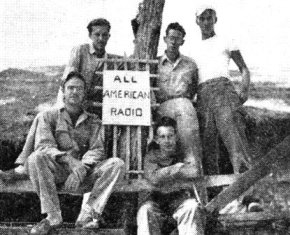 The furtherest south in Burma of American radio teams, these men are with the 36th Division of Maj. Gen. Francis
W. Festing's command. Left to right are T/4 Robert R. Krieg, Saginaw, Mich.; Pvt. Joseph Eichhorn, Brooklyn, N.Y.;
T/5 Phillip Kurpeawskk, Grenwich, Conn., (seated); Pvt. Norman W. Irion, Westfield, N.J., and T/5 William Fowler
of Stamford, Conn.
The furtherest south in Burma of American radio teams, these men are with the 36th Division of Maj. Gen. Francis
W. Festing's command. Left to right are T/4 Robert R. Krieg, Saginaw, Mich.; Pvt. Joseph Eichhorn, Brooklyn, N.Y.;
T/5 Phillip Kurpeawskk, Grenwich, Conn., (seated); Pvt. Norman W. Irion, Westfield, N.J., and T/5 William Fowler
of Stamford, Conn.
|
USE RUSSIAN VODKA FOR LIGHTER FLUID
HQ., CHINA WING, ATC - An officer, just arrived at one of the India-China Division's China bases, was relaxing in bed at the close of his first day of duty.
It was then that he received lesson number one on how to get along in China. As he watched, his roomate removed the cork from a large bottle of colorless liquid and carefully filled his lighter. A few minutes later, after he had finished shaving, he rubbed his face briskly with lotion - out of the same bottle. Then he took down a pair of trousers and removed two spots - still using the same magic fluid.
Once dressed, the officer opened a can of fruit juice and poured it into two glasses, adding generous slugs out of the bottle. The newcomer looked at his drink doubtfully, but his roomate reassured him.
"It's okay," he said, "pretty fair vodka made by a Russian in town. Up here in China, everything does double duty."
Nip Installations In Burma Take EAC Smashes
HQ., EASTERN AIR COMMAND - This has been a busy and fruitful week for Eastern Air Command.
It has seen culmination of the drive on Meiktila with the landing of Allied troops on the airfields there, the joint land-air assault which has brought the "Dagger" Division into the heart of Mandalay, two amazing air-sea rescues and the usual heavy battering of Japanese lines of communication and supplies.
As 14th Army troops poured out of USAAF Air Command and Combat Cargo Transports operating under the Combat Cargo Task Force, many must have paid silent tribute to Maj. Gen. O. C. Wingate, for the Meiktila triumph was founded on his genius, which a year ago had organized the fly-in behind the enemy's lines in Northern Burma.
WINGATE TRIBUTE
That earlier airborne expedition was the model for the fly-in of Allied armies into Normandy on D-Day. Now the wheel had turned full circle and here in Burma another great troop lift was made as successfully as the other two had been. Not a soldier, not an aircraft was lost during the non-stop delivery service onto fields which were under enemy fire.
BANGKOK HIT
Bangkok, one of the key points in this supply system, has taken heavy punishment in the last week. RAF Liberators dropped more than 150 tons on the Makasan railway workers and on the same day, 140 miles away to the northeast, USAAF B-24's of the Seventh Bomb Group of the Strategic Air Force made the second attack within three days on the railway junction of Korat.
Next day American heavies badly damaged two bridges on the railway to Burma from Bangkok and 24 hours later British bombers were pounding the railway yards in Siam's capital.
SEVEN BRIDGES
In the second half of the week, seven Burma-Siam railway bridges were destroyed or damaged by heavy bombers.
Another phase of this communications war was fought in the Northern Combat Area, where USAAF B-25 medium bombers on three successive days blocked roads supplying enemy troops retreating from Lashio. The B-25's have also made successful strikes against stores areas at Toungoo, Taungwwingyi and Pyawbwe, from which Japanese troops in the central zone are supplied.
AIR-SEA RESCUE
RAF Catalinas and Liberators brought the work of the air-sea rescue service into the limelight during the week: They helped to save 19 members of two B-29 Super-Fortress crews which had crashed in the Indian Ocean.
Catalinas accomplished the first rescue at a range of 800 miles, taking off some of the "ditched" airmen from a submarine which had picked them up. The second rescue, which involved a 2,300-mile flight, was the joint work of Liberators and of the Catalina which had taken the men off the submarine four days before.
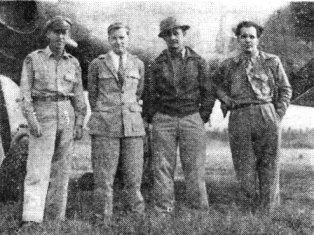 These men had much to do with conversion of B-25's to Malaria Control Spray units. Lt. Dodge E. Leary, Cambria,
Wis., test-flew the airplanes. Robert T. Wise, Cleveland, O., John J. Uebele, Pittsburgh, Pa., and Daniel Chako,
Girard, O., American civilians at Bangalore Air Depot of Air Service Command, participated in the tank and spray
installations.
These men had much to do with conversion of B-25's to Malaria Control Spray units. Lt. Dodge E. Leary, Cambria,
Wis., test-flew the airplanes. Robert T. Wise, Cleveland, O., John J. Uebele, Pittsburgh, Pa., and Daniel Chako,
Girard, O., American civilians at Bangalore Air Depot of Air Service Command, participated in the tank and spray
installations.
|
B-25 BOMBERS BLAST NIPS AND MOSQUITOES
HQ., INDIA-BURMA AIR SERVICE COMMAND - Originally, the B-25 Mitchell bomber came to India and Burma to blast Japs, but since its arrival, this plane has taken up the task of exterminating another kind of insect - the malaria-giving Anopheles mosquito.
For waging war against the mosquito, the B-25's have been re-fitted with special tanks to spray DDT solution, the new mosquito destroyer, on large areas of swamp land and infected jungle.
The idea of spraying insecticide from a swiftly-moving airplane is not new, but it is believed that the actual spray ship constructed at the Bangalore Air Depot is the first of its kind. The present project is the outgrowth of U.S. Medical Officers' campaign to control the ravages of malaria.
Behind the successful application of the DDT bomber lies the teamwork of numerous American military and civilian mechanical experts of the Air Service Command's Bangalore Air Depot, Mr. Christian J. Ohlschlager, American Technical Instructor, had much to do with the creation of a workable tank and spray system. Working with him on this were Robert T. Wise, an American engineer, and U.S. mechanical experts Daniel Chako and John J. Uebele, both veterans of the Orient.
Expert Indian airplane mechanics, who participated in the conversion work, were H. N. Delawala and A. G. Khan.
When the tank, valve and spray pipe system had been built and installed, Lt. Dodge E. Leary stepped in to test-fly this new weapon against our enemy.
COURT FREES AAF OFFICER IN KUNMING
KUNMING - A 31-year-old lieutenant colonel has been acquitted by a general court-martial here of voluntary manslaughter after firing two mercy bullets into the head of a sergeant hopelessly trapped in a burning plane.
The general court-martial of seven colonels was drawn from the 14th Air Force and Service organizations. The verdict was rendered after 10 witnesses were heard.
SERGEANT TRAPPED
The incident occurred Jan. 18, when a bomber overshot the runway. Rescuers reached the plane, which was aflame, almost immediately. The pilot, co-pilot and sergeant gunner were in the top turret. The co-pilot, who was dead, and the pilot, seriously injured, were pulled out immediately.
But the sergeant was pinioned tightly behind the armor plate backing the co-pilot's seat. All efforts to remove him were in vain. His legs were hopelessly entangled and physicians could not get into a position to amputate.
FIRED TWICE
All hope of rescue had been given up, witnesses testified, when the lieutenant colonel, standing about 15 feet away, fired twice at the sergeant's head where it showed in the wreckage.
At the court-martial, defense counsel Lt. Col. John H. Henerson of Kansas City, Mo., rather than base the case on the contention the shooting was an act of mercy, brought out testimony intended to show the defendant acted irrationally while under strain.
MEDICAL EVIDENCE
The main pillar of the defense, however, was medical evidence showing that there was reasonable doubt the sergeant had indeed died from bullets rather than burning.
Neither victim nor accused was identified by the Army. The defendant was commander of a fighter group, veteran of 80 air missions and ranking officer at the base.
The Roundup is a weekly newspaper of the United States Forces, published by and for the men in Burma and India, from news and pictures supplied by staff members, soldier correspondents, United Press, OWI, and Army News Service. The Roundup is published Thursday of each week and is printed by The Statesman in New Delhi and Calcutta, India. Editorial matter should be sent directly to Capt. Floyd Walter, Hq., U.S.F., I.B.T., New Delhi, India, and should arrive not later than Sunday in order to be included in that week's issue. Pictures must arrive by Saturday and must be negatives or enlargements. Stories should contain full name and organization of sender. Complaints about circulation should be sent directly to Lt. S.R. Rose, Hq., U.S.F., I.B.T., New Delhi, India. Units on the mailing list should make notification of any major change in personnel strength or any change of APO.

MARCH 15, 1945
Original issue of India-Burma Theater Roundup shared by CBI veteran Tom Miller.
Copyright © 2006 Carl Warren Weidenburner
TOP OF PAGE PRINT THIS PAGE ABOUT THIS PAGE SEND COMMENTS
PREVIOUS ISSUE CLOSE THIS WINDOW NEXT ISSUE